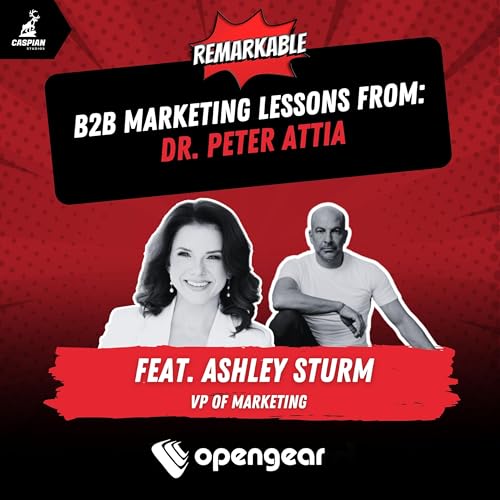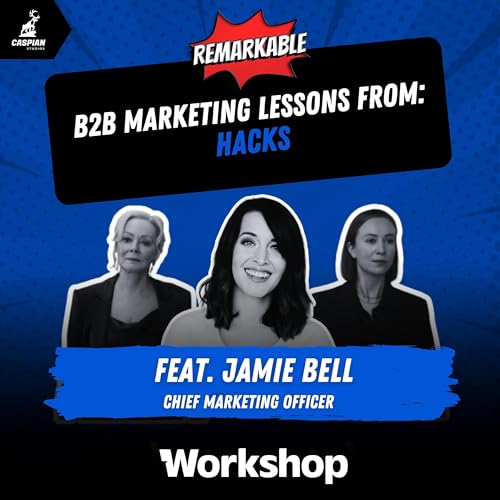In comedy, the punchline only works if it lands with the audience—and B2B marketing is no different.
That’s what we can learn from Hacks, a show about a legendary comedian reinventing herself with the help of a Gen Z writer. In this episode, we’re breaking down its lessons with the help of special guest Jamie Bell, Chief Marketing Officer at Workshop.
Together, we explore what B2B marketers can learn from creating a “writer’s room” for fresh ideas, testing content like comedians test their sets, and embracing generational differences as a source of connection rather than division.
About our guest, Jamie Bell
Jamie Bell is the CMO at Workshop. She is a marketing leader with a passion for building brands in underestimated industries and demand engines that keep sales teams busy (in a good way!).
Over the past 12+ years, Jamie has been lucky enough to work in several early- and growth-stage companies in SaaS, e-commerce, retail, and media.
What B2B Companies Can Learn From Hacks:
- Create a “writer’s room” for marketers. Great campaigns don’t just come from formal briefs—they need a space for messy, creative riffing. Jamie explains, “We didn’t have a writer’s room, at least at Workshop, and so when I came back from maternity leave, we added a meeting. We called it the pitch deck… it’s just like an open forum for people to do like five-minute pitches, and we just creatively layer on, and it’s been a blast.” The lesson? Carve out judgment-free time for brainstorming, where small sparks can snowball into big campaigns.
- Test your material before scaling. Like comedians who try new jokes on the road, marketers should pilot ideas before investing heavily. Jamie notes, “She does road shows, before to test the set list. So we do some things in like our Happy Monday Club newsletter, where before we’ll like super invest in a piece of content, we’ll just see if it does better than the other content in that newsletter, and see what the reception of that is before we blow it up a bit.” The takeaway: use small, low-risk formats to gauge response, then double down on what resonates.
- Bridge generational divides head-on. Hacks thrives on the clash between an aging comedy legend and a Gen Z writer, two perspectives that seem at odds, but create brilliance together. Jamie ties this directly to marketing: “There’s so much about marketing and internal communications that I feel is around generational differences… and I think the idea that you take that relationship, you’re unapologetic about it and you just talk about it head on… I think it’s really great too.” In B2B marketing, don’t shy away from generational dynamics; embrace them as a rich source of storytelling and connection.
Quote
“ Employees are your best brand ambassadors, and you need to spend some effort rolling out things internally. Having employees connected to the mission, the vision, the values.”
Time Stamps
[00:55] Meet Jamie Bell, Chief Marketing Officer at Workshop
[01:33] Why Hacks?
[02:07] The Role of CMO at Workshop
[03:07] What is the Happy Monday Club?
[04:45] The Concept and Creation of Hacks
[20:16] Marketing Lessons from Hacks
[41:38] Importance of Community and Events
[44:03] Workshops' Content Strategy
[45:04] Advice for a first-time CMO
[48:38] Final Thoughts and Takeaways
Links
Connect with Jamie on LinkedIn
Learn more about Workshop
About Remarkable!
Remarkable! is created by the team at Caspian Studios, the premier B2B Podcast-as-a-Service company. Caspian creates both nonfiction and fiction series for B2B companies. If you want a fiction series check out our new offering - The Business Thriller - Hollywood style storytelling for B2B. Learn more at CaspianStudios.com.
In today’s episode, you heard from Ian Faison (CEO of Caspian Studios) and Meredith Gooderham (Head of Production). Remarkable was produced this week by Jess Avellino, mixed by Scott Goodrich, and our theme song is “Solomon” by FALAK.
Create something remarkable. Rise above the noise.
Hosted by Simplecast, an AdsWizz company. See pcm.adswizz.com for information about our collection and use of personal data for advertising.
 50 分
50 分 41 分
41 分 50 分
50 分 41 分
41 分 45 分
45 分 53 分
53 分 42 分
42 分 51 分
51 分

